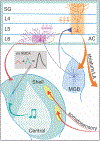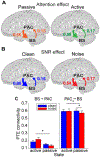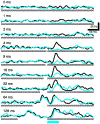Diverse functions of the auditory cortico-collicular pathway
- PMID: 35351323
- PMCID: PMC9485291
- DOI: 10.1016/j.heares.2022.108488
Diverse functions of the auditory cortico-collicular pathway
Abstract
Sensory processing is frequently conceptualized as a linear flow of information from peripheral receptors through hierarchically organized brain regions, ultimately reaching the cortex. In reality, this ascending stream is accompanied by massive descending connections that cascade from the cortex toward more peripheral subcortical structures. In the central auditory system, these feedback connections influence information processing at virtually every level of the pathway, including the thalamus, midbrain, and brainstem, and exert influence even at the level of the cochlea. The auditory cortico-collicular system, which connects the auditory cortex to the auditory midbrain, mediates manifold functions ranging from tuning shifts to defense behavior. In this review, we first summarize recent findings regarding the anatomical organization and physiological properties of the auditory cortico-collicular pathway. We then highlight several new studies that show that this projection system mediates high-level cognitive processes, acoustico-motor behaviors, and auditory plasticity, and discuss the circuit mechanisms through which they are mediated. Finally, we discuss remaining unanswered questions regarding cortico-collicular circuitry and function and potential avenues for future exploration.
Keywords: Auditory cortex; Cortico-collicular; Cortico-fugal; Inferior colliculus; Top-down.
Copyright © 2022. Published by Elsevier B.V.
Figures





Similar articles
-
Auditory cortical projections to the cat inferior colliculus.J Comp Neurol. 1998 Oct 19;400(2):147-74. J Comp Neurol. 1998. PMID: 9766397
-
Auditory cortex shapes sound responses in the inferior colliculus.Elife. 2020 Jan 31;9:e51890. doi: 10.7554/eLife.51890. Elife. 2020. PMID: 32003747 Free PMC article.
-
Corticofugal regulation of predictive coding.Elife. 2022 Mar 15;11:e73289. doi: 10.7554/eLife.73289. Elife. 2022. PMID: 35290181 Free PMC article.
-
The auditory corticocollicular system: molecular and circuit-level considerations.Hear Res. 2014 Aug;314:51-9. doi: 10.1016/j.heares.2014.05.004. Epub 2014 Jun 7. Hear Res. 2014. PMID: 24911237 Free PMC article. Review.
-
Descending projections to the auditory midbrain: evolutionary considerations.J Comp Physiol A Neuroethol Sens Neural Behav Physiol. 2023 Jan;209(1):131-143. doi: 10.1007/s00359-022-01588-5. Epub 2022 Nov 3. J Comp Physiol A Neuroethol Sens Neural Behav Physiol. 2023. PMID: 36323876 Free PMC article. Review.
Cited by
-
Perceptual warping exposes categorical representations for speech in human brainstem responses.Neuroimage. 2023 Apr 1;269:119899. doi: 10.1016/j.neuroimage.2023.119899. Epub 2023 Jan 28. Neuroimage. 2023. PMID: 36720437 Free PMC article.
-
Differential cholinergic innervation of lemniscal versus non-lemniscal regions of the inferior colliculus.J Chem Neuroanat. 2024 Sep;139:102443. doi: 10.1016/j.jchemneu.2024.102443. Epub 2024 Jun 22. J Chem Neuroanat. 2024. PMID: 38914378 Free PMC article.
-
Learning induces unique transcriptional landscapes in the auditory cortex.Hear Res. 2023 Oct;438:108878. doi: 10.1016/j.heares.2023.108878. Epub 2023 Aug 26. Hear Res. 2023. PMID: 37659220 Free PMC article. Review.
-
Two Prediction Error Systems in the Nonlemniscal Inferior Colliculus: "Spectral" and "Nonspectral".J Neurosci. 2024 Jun 5;44(23):e1420232024. doi: 10.1523/JNEUROSCI.1420-23.2024. J Neurosci. 2024. PMID: 38627089 Free PMC article.
-
Sound-evoked auditory neurophysiological signals are a window into prodromal functional differences in a preclinical model of Alzheimer's Disease.bioRxiv [Preprint]. 2025 Aug 11:2025.08.07.669134. doi: 10.1101/2025.08.07.669134. bioRxiv. 2025. PMID: 40832270 Free PMC article. Preprint.
References
-
- Andersen RA, Snyder RL, & Merzenich MM (1980). The topographic organization of corticocollicular projections from physiologically identified loci in the AI, AII, and anterior auditory cortical fields of the cat. Journal of Comparative Neurology, 191(3), 479–494. - PubMed
Publication types
MeSH terms
Grants and funding
LinkOut - more resources
Full Text Sources

